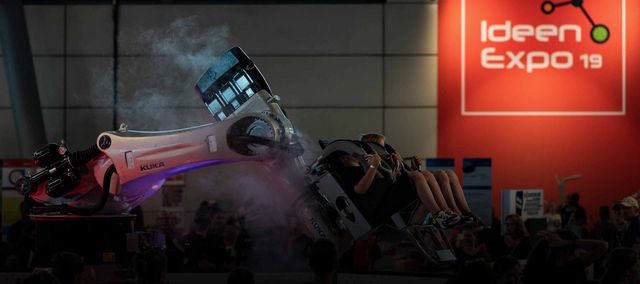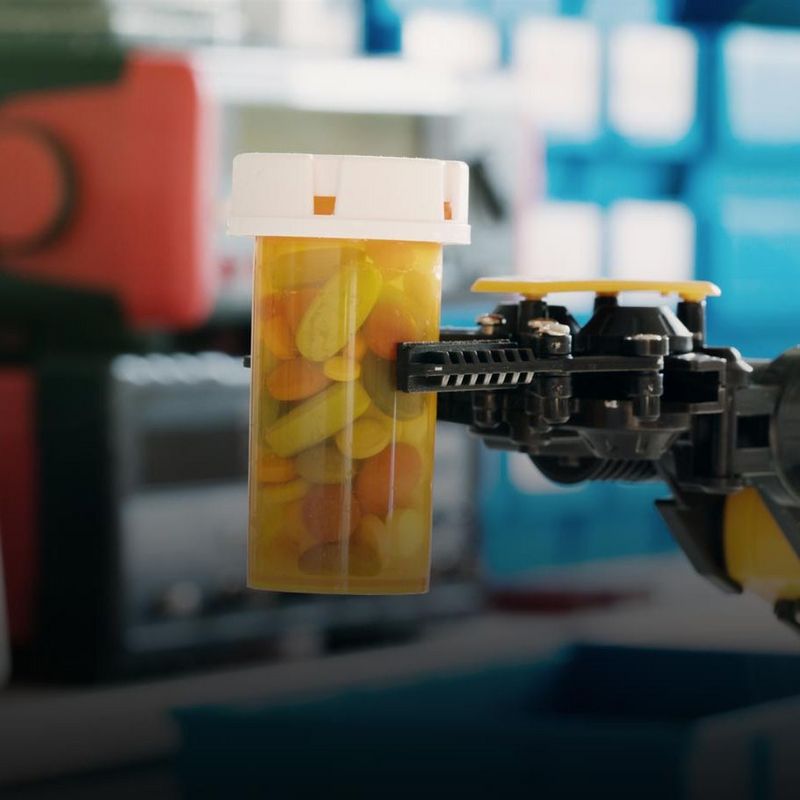08 July 2019
“Just do it!” It’s under this banner that the IdeenExpo in Hanover aims to inspire children and young people to take up professions in science and technology. This year marked the seventh outing for this hands-on exhibition: Nearly 400,000, mostly school-aged visitors thronged the idea halls, trying out 670 hands-on exhibits and putting themselves to the test in the 730 workshops run by the 270 exhibiting companies, research institutions and universities. #explore took a look around "Europe's largest young people’s event for science and technology".
Puffing, panting and laughing - all the while with an ambitious glint in their eyes - a mother, a father, a son and a daughter all push down on the rubber torsos of their resuscitation dolls. Just how well they’re doing at first aid is revealed by a digital ambulance heading toward a virtual finishing line on a screen. “It’s not about pushing as fast as you can; it’s a matter of finding the right rhythm and point on the chest,” explains a St. John’s ambulanceman squatting down next to the group. He then goes on to explain to them what heart-lung resuscitation is all about and why it is so crucial to fill the gap until professionals like him arrive at the scene of the accident.
© Oliver HardtKeep pumping until the paramedic arrives: At the St. John's Ambulance, visitors use playful means to find out what first aid is all about.
The declared aim of the IdeenExpo, which opened its doors to the public in Hanover for the seventh time this year, is to use playful means to introduce children and young people to science and technology. And there’s clearly a need for it: According to a recent study, 311,300 specialist vacancies in the STEM (Science, Technology, Engineering and Mathematics) field were unfilled in April this year – a new negative record that the exhibiting companies, universities and institutions, which number some 270 in total, want to do something about at IdeenExpo. Grouped around nine themes – from “Digital Worlds” and the “Mobility Arena”, right through to “Girls and STEM” and the “Climate Zone” – 670 hands-on exhibits and over 730 workshops extend an open invitation to tinker, drill holes and experiment. What’s more, to mark the 50th anniversary of the moon landing, the organisers have also recreated the Apollo mission's lunar module.
An offer that is obviously going down well: The employees of the hands-on show standing at the main entrances with manual counting devices can barely click people through fast enough. This Saturday, it’s families in particular who are exploring the four “Ideas Halls” and the grounds. Here on the big show stage, science journalist Ranga Yogeshwar and the audience have just started the countdown to the release of a weather balloon. In Hall 9, meanwhile, 12-year-old Vitória is learning how to make rubber from the latex juice of the rubber tree. Dressed in a white protective coat, she sits next to her father Richard in the laboratory of the German Institute of Rubber Technology, concentrating on stirring with a glass rod a beaker in which the natural rubber, still soft, is floating. Father and daughter have also just taken part in a quiz, followed by a slush puppy for refreshment. “But making rubber was the thing I enjoyed most,” says Vitória with shining eyes.
Test driving an autonomous car
At the other end of the production cosmos, the RoboCoaster is causing the heart rate and adrenaline levels of two young people to soar. In the automotive industry, the robotic articulated arm built by KUKA is part of everyday work. But there’s one crucial difference: instead of the usual gripper at the end of the arm, there’s a passenger gondola. In this way, people can experience at first-hand how quickly and flexibly the six-axle five-tonne vehicle can move in a wide variety of directions.
© Oliver HardtShaken up by robotics: The RoboCoaster was particularly popular.
Across the way, on the stand of automotive supplier ZF, a boy is getting a taste of autonomous driving. He’s sitting in a kind of motorised go-kart and holding a tablet. When he turns it to the left, the vehicle follows suit – this is supposed to simulate the controlling impulses for an automated vehicle, which ZF has been researching for some time. What it’s like to work in a networked factory in the age of Industry 4.0 is being demonstrated on the stand next to the driving arena. On a wardrobe-sized production line you can assemble a Lego figure. If you take the blocks for the next stage out of the wrong box, a red warning lamp lights up. A few metres away, a twelve-year-old just manages by the skin of his teeth to avoid hitting a wall, jerking the steering wheel around at the last moment and steering back to the digital race track on which he is focused through his virtual reality glasses.
Experiencing the consequences of climate change close up
Virtual Reality (VR) is the big thing everywhere at the IdeenExpo. At the stand of the Leibniz University of Hanover, a girl has just embarked on a roller coaster ride in cyberspace. On the seat next to her, you can even construct your own roller coaster and take it for a spin. In this way, the power of play is harnessed to communicate what civil engineers have to look out for: “If the route’s marked in red, the centrifugal force would cause the car to career off the track – which is obviously something you want to avoid,” explains student Oliver Bergefeld. After the test you also get to see how often your own roller coaster has achieved “Zero G”, otherwise known as weightlessness. “After all, that's what makes riding a roller coaster such fun,” says the budding civil engineer.
In front of the climate dome, meanwhile, people big and small are queuing up to broaden their horizons. From the outside, this exhibit of the Federal Ministry for Economic Cooperation and Development resembles a walk-in inflatable globe. Inside, in a short virtual-reality documentary, people get an immediate sense of how climate change is affecting the lives of people in Madagascar. Heat lamps ensure that you get to feel the baking heat of this island of the coast of southern Africa for yourself.
Alexander Nikonov, whose job is to oversee the climate dome, is pretty impressed by the hands-on fair and has already tried a few things out for himself. “You can relive your childhood here,” Nikonov laughs. At the NDR stand, he has seen how a TV show is created and, in “Digital Worlds”, how a computer game is programmed. “You often don't even know what kinds of professions are out there. But here, kids and young people get to see the whole range. And they don’t even have to pay.”
Supporting nurses with sensors
Some of the students have brought their own innovative projects, which they are presenting as part of the “Ideenfang” competition. The team from the Freiherr-vom-Stein-Oberschule in Nordhorn on the Dutch border, for example, has developed a medical wet scanner: a nappy equipped with sensors for use in hospitals. “Nurses just have to consult an app to see where they need to change nappies or replace the sheets,” explains student Sina. A boon for both nurses and those patients who then don’t have to lie in wet beds for so long. Sina and her 30 classmates from the technical class have been working on the development, implementation and programming of the app for some six months. “It shouldn’t look too spartan, but nor should it be overly complicated - and it needs to be feasible for us to make it,” she says by way of explanation of the challenge involved. Last year, the tech-class tinkerers won the “Special Prize for Originality” at an Airbus ideas competition – for a VR video designed to take away people's fear of flying. As teacher Ralf Snieders explains, the school has now brought a project to the IdeenExpo for the third time.
Eva Schütze, on the other hand, is a newcomer - and is visibly thrilled: She and her children are in the process of inspecting the NAO robots at the robot factory stand. “I think it's brilliant that things like robotics or computer science are presented to the children here so straightforwardly and without obstacles to understanding. If this had been around in my time, I’d have been completely up for it myself,” Schütze says with enthusiasm. Her daughter Sarah-Sophie and her friend Lotta are also visibly impressed. The two twelve-year-olds particularly liked the hot air balloon. “And we were allowed to do some programming, which was really cool!" Sarah-Sophie interjects. Her brother is about to turn 16. As as he’s concerned, his mother Eva says, the IdeenExpo is soon going to be an interesting place to get in touch with companies before he starts his higher education or sets out on his career path. “After all, making contacts is easy here. We'll definitely be back next time.”










